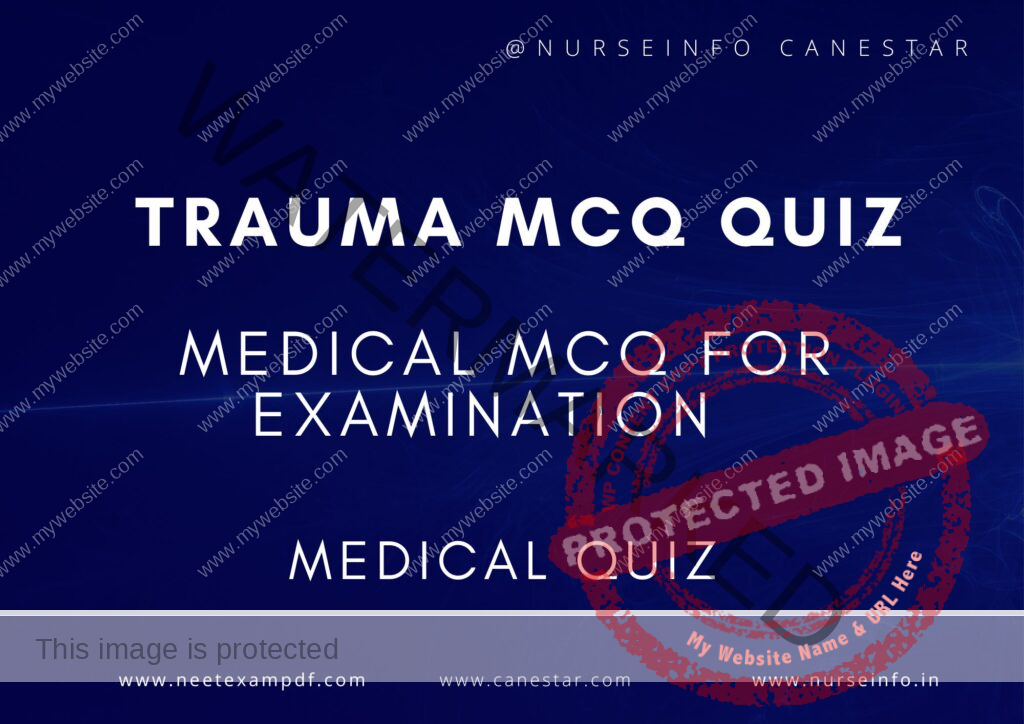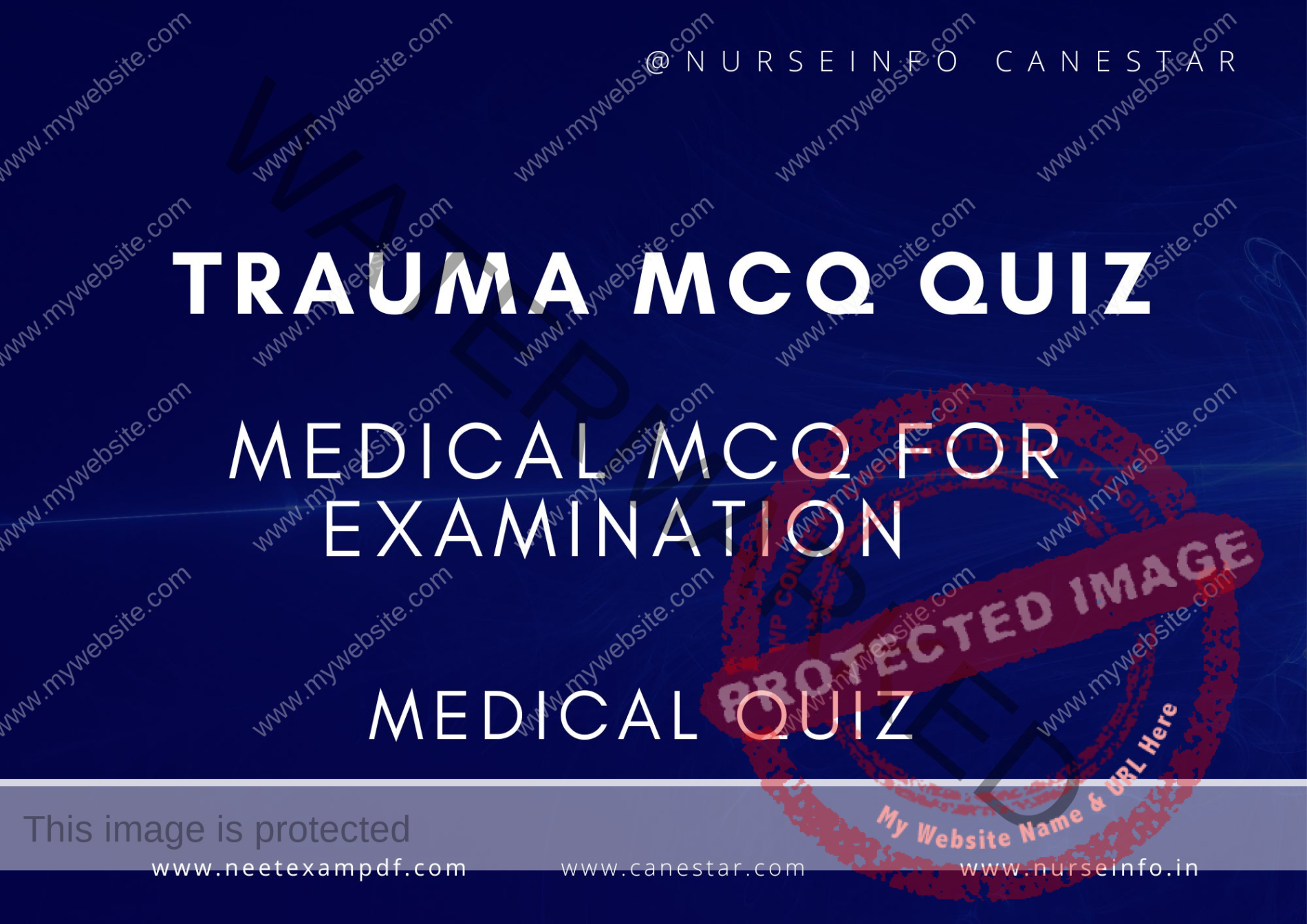MULTIPLE CHOICE QUESTIONS ON TRAUMA CARE MCQ QUIZ – MCQS WITH RATIONALE ANSWER – TRAUMA CARE MCQ QUESTIONS WITH RATIONALE
MCQ FOR TRAUMA CARE QUIZ
These mcqs are prepared exclusively for medical professionals for exam preparation. MCQ is helpful to remember the concept on trauma care mcq quiz. This multiple choice questions are helpful for preparation for DHA, PROMETRIC, MOH, HAAD, NCLEX, Medical, NEET and Nursing EXAMINATION
TRAUMA CARE MCQ QUIZ
Trauma MCQs with Rationale
1. Which of the following is the primary survey in trauma care?
A. Airway, Breathing, Circulation, Disability, Exposure
B. History, Inspection, Palpation, Auscultation, Percussion
C. Assessment, Diagnosis, Planning, Implementation, Evaluation
D. Primary, Secondary, Tertiary, Quaternary
Answer: A. Airway, Breathing, Circulation, Disability, Exposure
Rationale: The primary survey in trauma care follows the ABCDE approach to rapidly assess and manage life-threatening conditions.
2. In a trauma patient, the most immediate threat to life is usually:
A. Spinal cord injury
B. Airway obstruction
C. Fractured femur
D. Pelvic fracture
Answer: B. Airway obstruction
Rationale: Airway obstruction is the most immediate threat to life as it can quickly lead to hypoxia and cardiac arrest if not promptly managed.
3. Which of the following signs is most suggestive of a tension pneumothorax?
A. Hypotension and distended neck veins
B. Hypotension and bradycardia
C. Hypertension and distended neck veins
D. Hypertension and bradycardia
Answer: A. Hypotension and distended neck veins
Rationale: Tension pneumothorax causes hypotension due to decreased venous return and distended neck veins due to increased intrathoracic pressure.
4. What is the best initial management for an open pneumothorax?
A. Chest tube insertion
B. Needle decompression
C. Occlusive dressing
D. Positive pressure ventilation
Answer: C. Occlusive dressing
Rationale: An occlusive dressing (sealed on three sides) is applied initially to prevent air from entering the pleural space while allowing air to escape, stabilizing the patient before further interventions.
5. A patient presents with a flail chest. What is the primary concern in managing this condition?
A. Pain management
B. Preventing infection
C. Ensuring adequate ventilation
D. Stabilizing the rib fractures
Answer: C. Ensuring adequate ventilation
Rationale: Flail chest compromises ventilation due to paradoxical chest wall movement. Ensuring adequate ventilation is crucial to maintain oxygenation and prevent respiratory failure.
6. In the secondary survey of a trauma patient, which of the following is most important?
A. Detailed physical examination
B. Rapid assessment of vital signs
C. Initial blood tests
D. Administration of pain relief
Answer: A. Detailed physical examination
Rationale: The secondary survey involves a thorough head-to-toe examination to identify all injuries after life-threatening conditions have been addressed.
7. What is the most common cause of shock in trauma patients?
A. Cardiogenic shock
B. Hypovolemic shock
C. Neurogenic shock
D. Septic shock
Answer: B. Hypovolemic shock
Rationale: Hypovolemic shock, usually due to hemorrhage, is the most common cause of shock in trauma patients, leading to decreased blood volume and impaired tissue perfusion.
8. A trauma patient with suspected spinal injury should be immobilized using:
A. A traction splint
B. A backboard and cervical collar
C. A pelvic binder
D. A tourniquet
Answer: B. A backboard and cervical collar
Rationale: Immobilization with a backboard and cervical collar prevents further injury to the spinal cord during transport and initial assessment.
9. Which imaging modality is most appropriate for evaluating abdominal trauma?
A. Plain X-ray
B. Ultrasound (FAST)
C. MRI
D. Bone scan
Answer: B. Ultrasound (FAST)
Rationale: The Focused Assessment with Sonography for Trauma (FAST) is a rapid bedside ultrasound used to detect free fluid in the abdomen, indicating potential internal bleeding.
10. Which of the following interventions is crucial in the initial management of a patient with a traumatic brain injury?
A. Hyperventilation
B. Administration of mannitol
C. Ensuring adequate oxygenation
D. Inducing hypothermia
Answer: C. Ensuring adequate oxygenation
Rationale: Ensuring adequate oxygenation is crucial to prevent secondary brain injury from hypoxia. Other interventions may follow based on the patient’s condition.
11. What is the most common site of injury in a blunt abdominal trauma?
A. Liver
B. Spleen
C. Kidneys
D. Pancreas
Answer: B. Spleen
Rationale: The spleen is the most commonly injured organ in blunt abdominal trauma due to its location and relatively fragile structure.
12. In a patient with a pelvic fracture, what is the priority in initial management?
A. Pain relief
B. Fluid resuscitation
C. Surgical repair
D. Immobilization with a pelvic binder
Answer: D. Immobilization with a pelvic binder
Rationale: Immobilization with a pelvic binder stabilizes the fracture and reduces bleeding, which is critical in the initial management of pelvic fractures.
13. Which of the following is a classic sign of basilar skull fracture?
A. Battle’s sign
B. Cullen’s sign
C. Grey Turner’s sign
D. Murphy’s sign
Answer: A. Battle’s sign
Rationale: Battle’s sign (bruising behind the ears) is a classic sign of basilar skull fracture, indicating potential injury to the base of the skull.
14. In a patient with a suspected spinal cord injury, which of the following is the most appropriate initial imaging study?
A. CT scan
B. MRI
C. X-ray
D. Ultrasound
Answer: A. CT scan
Rationale: A CT scan is the initial imaging study of choice for suspected spinal cord injury due to its ability to quickly and accurately identify fractures and other bony injuries.
15. What is the most appropriate initial treatment for a patient with a suspected limb compartment syndrome?
A. Elevation of the limb
B. Application of ice packs
C. Fasciotomy
D. Compression bandage
Answer: C. Fasciotomy
Rationale: Fasciotomy is the definitive treatment for compartment syndrome, relieving pressure within the compartment to prevent tissue necrosis and loss of function.
16. Which of the following is the preferred fluid for initial resuscitation in a trauma patient?
A. Normal saline
B. D5W
C. Half-normal saline
D. Lactated Ringer’s
Answer: D. Lactated Ringer’s
Rationale: Lactated Ringer’s is preferred for initial resuscitation as it closely resembles the body’s plasma electrolyte composition and helps to correct acidosis.
17. Which of the following is a sign of a pericardial tamponade?
A. Pulsus paradoxus
B. Hypertension
C. Increased pulse pressure
D. Loud heart sounds
Answer: A. Pulsus paradoxus
Rationale: Pulsus paradoxus (a significant drop in blood pressure during inspiration) is a classic sign of pericardial tamponade, where fluid accumulation in the pericardium impairs cardiac function.
18. A trauma patient presents with hypotension, distended neck veins, and muffled heart sounds. What is the likely diagnosis?
A. Tension pneumothorax
B. Cardiac tamponade
C. Hemothorax
D. Aortic dissection
Answer: B. Cardiac tamponade
Rationale: The combination of hypotension, distended neck veins, and muffled heart sounds is known as Beck’s triad, which is indicative of cardiac tamponade.
19. Which of the following is the best indicator of effective resuscitation in a trauma patient?
A. Blood pressure
B. Heart rate
C. Urine output
D. Respiratory rate
Answer: C. Urine output
Rationale: Urine output is a reliable indicator of effective resuscitation and adequate perfusion, reflecting kidney function and overall volume status.
20. In a patient with a gunshot wound to the abdomen, what is the most important initial management step?
A. Administering antibiotics
B. Surgical exploration
C. Applying a tourniquet
D. Performing an abdominal ultrasound
Answer: B. Surgical exploration
Rationale: Immediate surgical exploration is critical for gunshot wounds to the abdomen to control bleeding, repair injuries, and prevent further complications.


